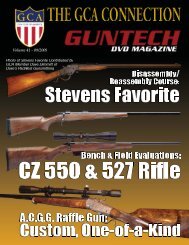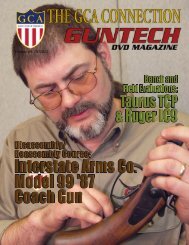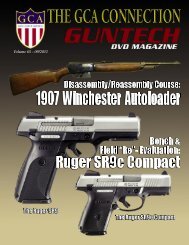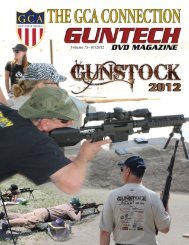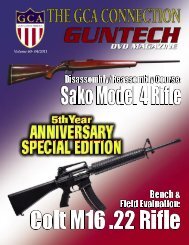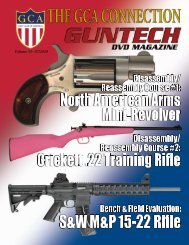GCA-Newsletter_04_12.. - Gun Club of America
GCA-Newsletter_04_12.. - Gun Club of America
GCA-Newsletter_04_12.. - Gun Club of America
Create successful ePaper yourself
Turn your PDF publications into a flip-book with our unique Google optimized e-Paper software.
A lot <strong>of</strong> folks hear about annealing brass cartridges cases,<br />
and just assume it must be something that’s hard to do. Once<br />
you understand what annealing is, why it’s done, and what<br />
tools you need to do it, annealing is actually a fairly simple<br />
process.<br />
What is annealing?<br />
Annealing means heat treating the neck and shoulder <strong>of</strong> a<br />
brass cartridge case to make it s<strong>of</strong>ter so it will seal the<br />
chamber during firing. Unlike steel, brass gets s<strong>of</strong>ter as you<br />
heat treat it, not harder. What makes brass cartridges become<br />
harder is firing the cases in your gun, and then cold-working<br />
them in your reloading dies. Both those operations will cause<br />
brass to harden, which leads to splits and cracks in the necks<br />
and shoulders <strong>of</strong> your cases.<br />
Why do we anneal brass?<br />
One reason to anneal your brass is to extend its life, so you<br />
can reload it more times. One <strong>of</strong> the first signs that it’s time<br />
to anneal is splitting at the case mouth, or cracks in the neck<br />
or shoulders <strong>of</strong> your brass. Another thing to look out for is if<br />
it suddenly takes more pressure, or less pressure, to seat<br />
bullets into the cases than it used to.<br />
Once symptoms like these appear, many shooters think the<br />
brass is no longer usable and discard it. But as long as the<br />
primer pockets are still tight, these cartridge cases are still<br />
useable – if you anneal them properly.<br />
Another reason to anneal brass cases is if you are reforming<br />
them from a larger case to a smaller case, such as in making<br />
wildcat cartridges. When you set the shoulder back on the<br />
case, the neck walls will thicken from the shoulder’s extra<br />
brass, which will harden up as you work it into the new<br />
configuration. This area <strong>of</strong> the worked brass needs to be<br />
annealed so that when it is fire formed, it will seal the<br />
chamber and properly form out to the new configuration.<br />
No matter why you anneal your cases, the key to proper<br />
annealing is to not overheat the cases. When you use a flame<br />
to heat the neck and shoulder, make sure that you do not<br />
bring the brass to a bright, glowing red color. If the brass<br />
reaches a bright, glowing red, you have most likely overheated<br />
the case, and it will be unsafe to fire, even if you quickly<br />
quench it with water.<br />
8<br />
The Not-So-Arcane<br />
Art <strong>of</strong> Brass<br />
Annealing<br />
By Bob Blaine<br />
Sinclair Loading Technician<br />
Reprinted by permission <strong>of</strong> Sinclair International<br />
How was case annealing traditionally done?<br />
Many <strong>of</strong> us familiar with annealing were taught to fill the<br />
brass cases halfway with water, and then place them into a<br />
pan <strong>of</strong> water deep enough for the water level to reach halfway<br />
up the outside <strong>of</strong> the case. The water inside and outside the<br />
case acts as a heat sink to protect the base <strong>of</strong> the case from<br />
overheating.<br />
An annealing trick that my father showed me, when I was at<br />
the tender age <strong>of</strong> 10, was to work in a fairly dark area. As I<br />
heated the cases, they would start to glow with just enough<br />
color that I could just barely see it in the darkened room.<br />
Once the case heated up enough for this barely-glowing<br />
color to spread evenly around the neck and shoulder, I would<br />
tip it over with the torch head so the brass would quench in<br />
the water it was standing in. This process left the neck and<br />
shoulder <strong>of</strong> the case s<strong>of</strong>ter than the middle and<br />
lower portions <strong>of</strong> the case.<br />
How is modern annealing different?<br />
Today we have better ways <strong>of</strong><br />
annealing that are far more consistent<br />
than the old-fashioned<br />
method that I have just<br />
described. One <strong>of</strong> the best<br />
ways is to use the Hornady<br />
Annealing System, which<br />
we sell as item #<strong>04</strong>1220<br />
and is shown here.<br />
This kit comes with three<br />
different size case holders that will allow you to spin the case<br />
with your cordless screwdriver while it is in the flame for very<br />
uniform heating <strong>of</strong> the neck and shoulder area.<br />
Keep the case pointed mouth up and confine your propane<br />
torch flame to the shoulder area. The heat will rise into the<br />
neck on its own without overheating it. The Hornady<br />
Annealing System also includes a bottle <strong>of</strong> heat-sensitive<br />
paint called Tempilaq. This paint is designed to change color<br />
when heated to 475° F (246° C).<br />
We usually recommend applying the paint to the inside <strong>of</strong> the<br />
case mouth because the flame will ablate the paint from the<br />
outside <strong>of</strong> the case as it heats. You will be able to see the<br />
paint inside the case mouth change color as the brass case<br />
rotates, and when this occurs, you will want to let the case fall<br />
out <strong>of</strong> the holder into a pail <strong>of</strong> cool water to quench.<br />
Please keep in mind that you can vary how hot the brass gets<br />
by using different Tempilaq formulas that change colors at<br />
different temperatures. If you need different Tempilaqs for different<br />
temperatures, Brownells sells several versions <strong>of</strong> it.<br />
There are other types <strong>of</strong> modern annealing tools, such as ring<br />
type annealers that rotate at a set RPM as they move the<br />
Continue on page 9




